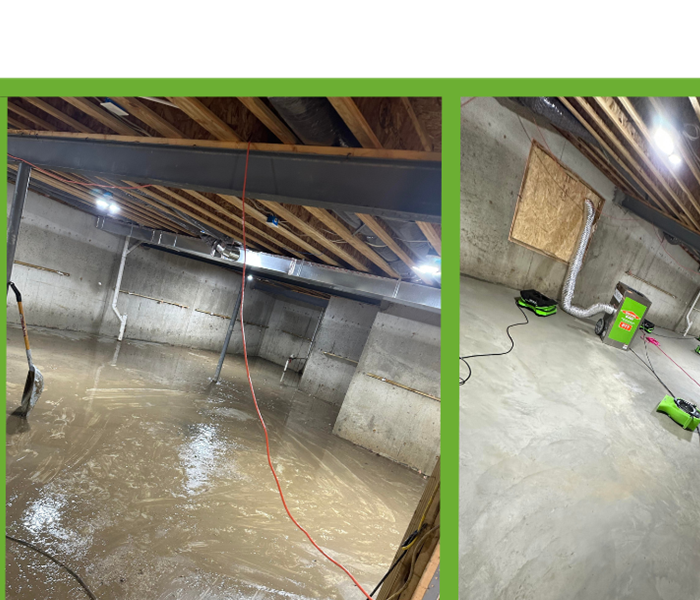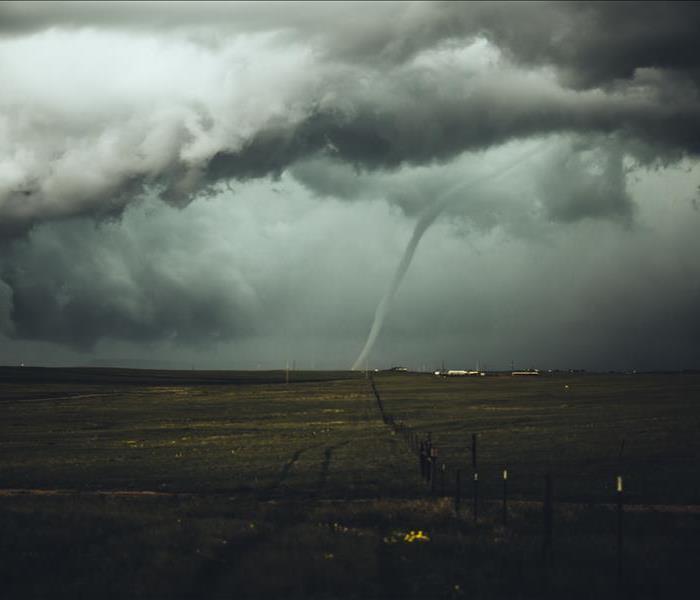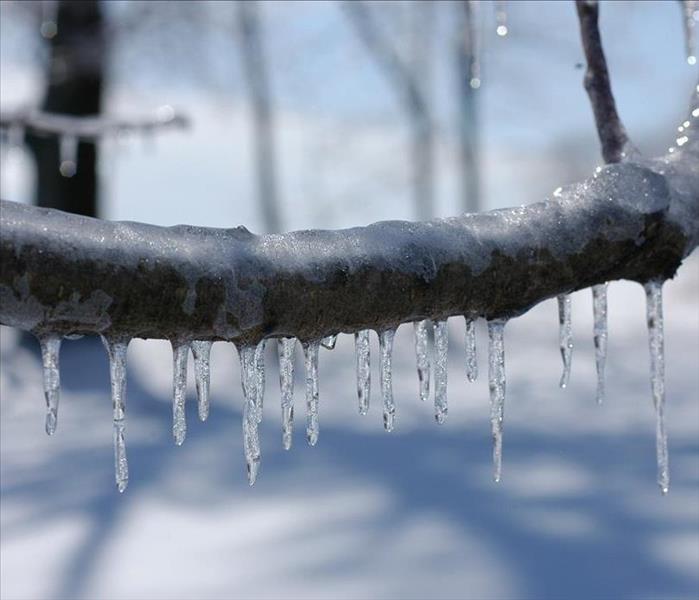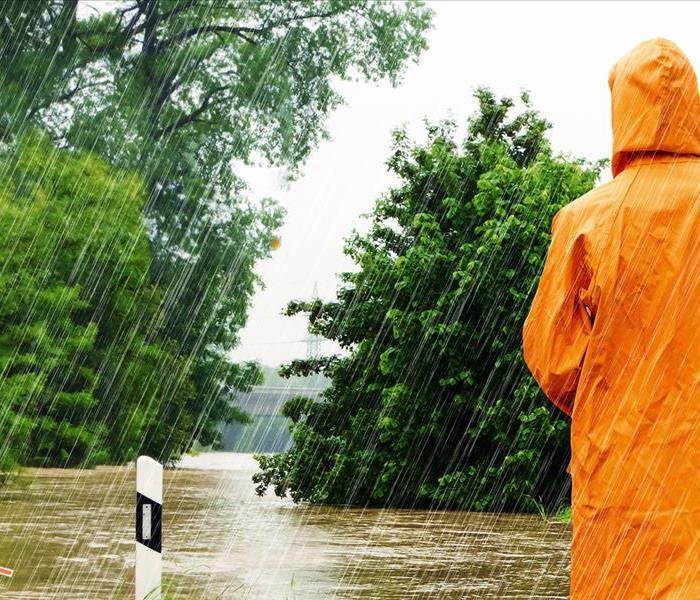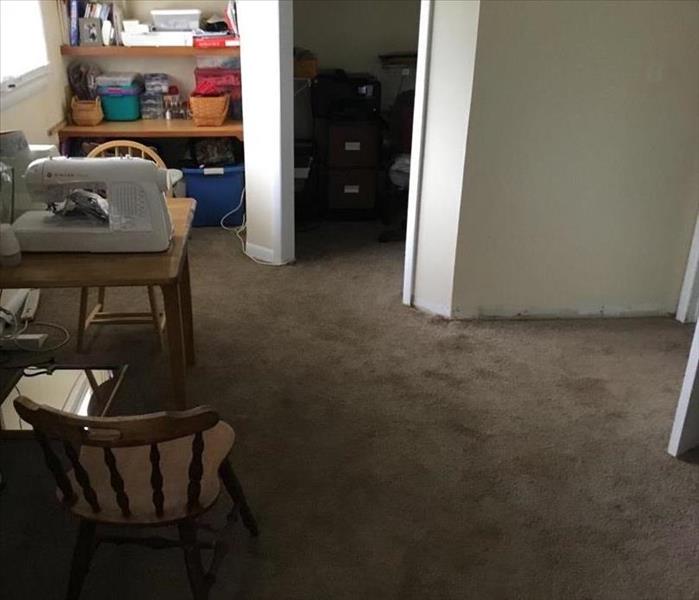Recent Storm Damage Posts
Storm Preparedness: Your Guide to Staying Safe Before, During, and After the Storm
9/23/2024 (Permalink)
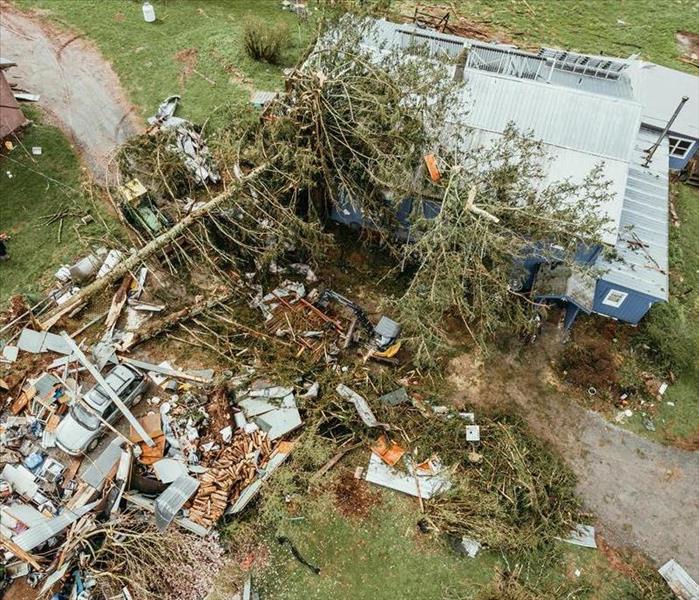 Storm damage can leave your home in ruins, but SERVPRO® is here to help with expert storm cleanup and restoration services.
Storm damage can leave your home in ruins, but SERVPRO® is here to help with expert storm cleanup and restoration services.
When it comes to storm preparedness, it’s all about planning ahead. Storms can strike quickly, leaving behind a trail of damage if you’re not ready. While you can’t control the weather, you can control how prepared you are. So, let’s dive into some practical steps to help keep you, your family, and your home safe when storms roll through.
Before the Storm: Preparation is Key
Start by staying informed. Keep an eye on weather updates from reliable sources and make sure your emergency kit is stocked with essentials like water, non-perishable food, flashlights, and first aid supplies. If you have time, secure outdoor furniture and any loose items that could become projectiles in high winds. Also, double-check that your home’s gutters and drainage systems are clear to prevent flooding.
During the Storm: Safety First
When the storm hits, stay indoors and avoid windows and doors. If you live in an area prone to flooding, move to higher ground and avoid walking or driving through floodwaters—it only takes six inches of fast-moving water to knock you down. Keep a battery-powered radio handy for real-time updates, and if the power goes out, don’t try to use generators indoors due to the risk of carbon monoxide poisoning.
After the Storm: The Road to Recovery
Once the storm has passed, the real work begins. Safety should be your first priority—avoid any downed power lines, and don’t enter any damaged buildings until they’ve been inspected by professionals. Flooding is a common issue after storms, and standing water can cause significant damage if left untreated. This is where calling in the pros can make all the difference. SERVPRO® has the expertise and equipment to assess storm damage, begin the drying process, and restore your property to its pre-storm condition. By acting quickly, you can minimize long-term damage and get back to normal faster.
Storms are unpredictable, but your response doesn’t have to be. With a little planning and the right help, you can weather the storm and come out stronger on the other side. Stay safe, and when in doubt, call SERVPRO®.
Michigan 2023: fast flooding requires fast action.
9/25/2023 (Permalink)
the recent flash flooding that occurred in Michigan left a lot of local resident in peril. In news reports they say some businesses were left as "Islands," and homes were virtually underwater. With all of the local company's overloaded with calls, we send our team of water mitigation specialists to help. After 3 weeks of working day and night our team helped many people get their homes cleaned up and ready for reconstruction. Some of the work done, included sewage backups in their basements, main floor flooding, or water coming in from the outside.
After leaving their families, driving across the country (South Carolina to Michigan) and then immediately getting to work to exact and dry, Our team has returned safely home.
What Storm Damage Looks Like
8/23/2022 (Permalink)
A terrible storm can cause an immense amount of damage to your home. Some visible to the naked eye some not. Below are a few things homeowners should look for.
- Roof: Look for shingles that have discoloration, tearing, or even holes in them. These can all be signs that your roof has been damaged. Another sign is if there are leaks in your roof or your ceiling.
- Gutters: After a hail storm, looking for dents or dings can also give you a better picture of what the storm did to the rest of your home. Your gutters can also give you insight to whether you have roof damage. Check to see if there are granules from the asphalt shingles in your gutter.
- Windows: Look at each of the windows at your homes and note any signs of shattered or broken windows and frame damage. This is especially important after a hail storm or a strong wind storm.
- Exterior: Not only is it important to look at the siding of your home to check for damage, it is also important that you check any appliances. Inspect your AC/HCAC unit as well as items such as a barbeque grill.
SERVPRO of South Greenville County has a 24/7 emergency response team that is well-versed to handle all storm damage,, 24 hour, 365 days a year emergency for any residential or commercial location.
Tips For Protecting Your Family During A Tornado In Greenville, SC.
9/7/2021 (Permalink)
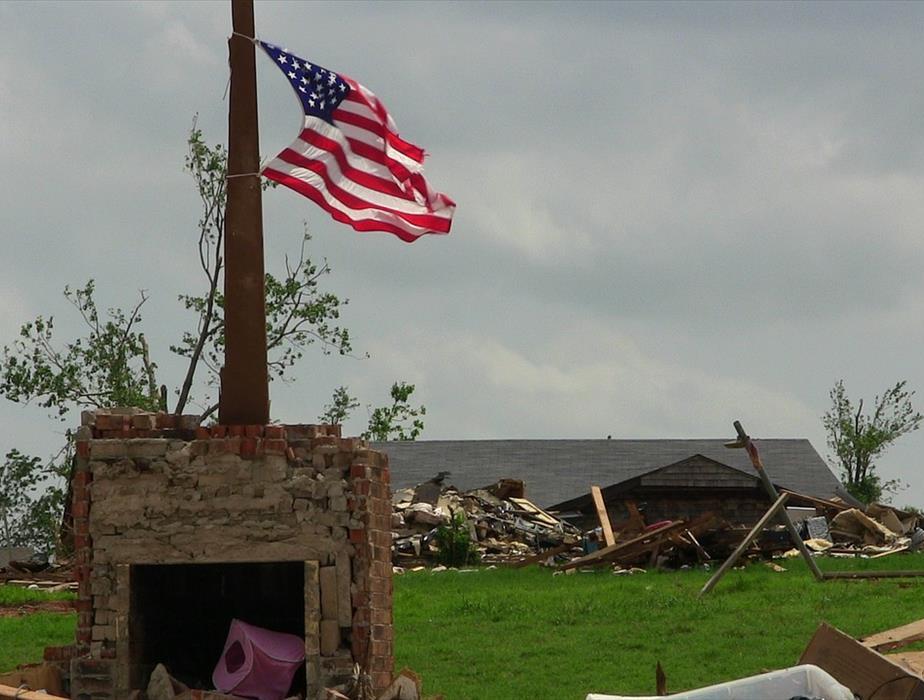 No matter the severity of the damage, we will make it "Like it never even happened."
No matter the severity of the damage, we will make it "Like it never even happened."
Tips For Protecting Your Family During A Tornado In Greenville, SC.
In recent years tornadoes and storm damage have become a reality for residents of Greenville, South Carolina. These storms usually pop up with little to no warning, and the key to staying safe is preparing in advance. Tornadoes are powerful and completely unpredictable, but by beginning to prepare now, you can better your odds of coming out of the storm unharmed.
Things You Need To Do Before The Storm
Sign Up Now for Local Emergency Agencies Alerts
Greenville's local emergency management agencies have a way for you to sign up to be alerted as soon as an emergency arises. These alerts include not just weather alerts but things like boil water notices and more.
The time to sign up for these alerts is before any weather emergency happens.
Know The Severe Weather Seasons and Language Used
Tornadoes
While pop-up tornadoes can happen at any time in South Carolina, spring and summer are when they most often occur.
Understanding Tornado Terms
Tornado Watch
During a tornado watch, you need to keep an eye on the sky.
Meaning the conditions exist for rotation to form in the blink of an eye.
Tornado Warning
There has been a tornado spotted on the ground or radar. You need to seek shelter immediately and stay there until the storm subsides.
Locate and Secure Possible Projectiles Before The Storm
Before you hear the weather siren going off, take the time to figure out what items in your yard could cause damage. If you cannot secure an item to the ground, it should be brought into your garage, shed, mudroom, or crawl space.
- Trampolines: If possible, youshould break down and store a trampoline or flip it over to be flush with the ground and anchor it. Doing so will prevent damage and keep them from becoming airborne.
- Patio Shade Shelters/Screen Tents: Secure the frame to the ground and remove all fabric components. Store fabric components in a garage, shed, or mudroom.
- Swing Sets / Playground Structures: Remove swings, see-saws, and any other removable features.
- Trash Cans/ Recycling Bins: Trash cans, garbage cans, compost bins, and recycling bins should be brought into a garage or placed in a shed.
Things You Can Do During The Storm To Protect You and Your Family
Seek Shelter During The Storm
- Basements: If you have a basement in your home, this is the preferred place to seek shelter. You should shelter at the below-ground end if it is a walk-out style.
- Lower-level, Interior Room: This is the second-best place to shelter if you do not have a basement. Preferably a room without a window.
- Upper-Level Rooms: will NOT protect you during a tornado. Do not shelter in upper-level rooms. Go to the lowest level of your home and shelter in your basement or an interior room without windows.
Stay Indoors During A Storm
It is tempting to look out the window or door during a storm, but you need to avoid rooms with windows or exterior doors. The safest place for you to shelter during a tornado is in a basement or a lower-level interior room with no windows. You and your family should stay dressed in clothes and shoes appropriate for the outdoor weather if you have to flee your home or shelter in a hurry.
What Not To Do After A Tornado
Do not let your curiosity get the better of you after a tornado. Even after the storm has passed, danger is still present. Downed power lines, storm surges, and washed-out roads can create rescue situations that have to pull emergency response and first responder teams away from other storm-related issues. If the damage is severe, it will still be there several days after the storm when conditions are safer for you to travel.
If you have storm damage to your home, call SERVPRO of South Greenville County(864) 292-3137. We are available 24/7, 365 days a year. No matter the severity of the damage, we will make it "Like it never even happened."
Do You Have A Safety Plan For Severe Weather?
7/28/2021 (Permalink)
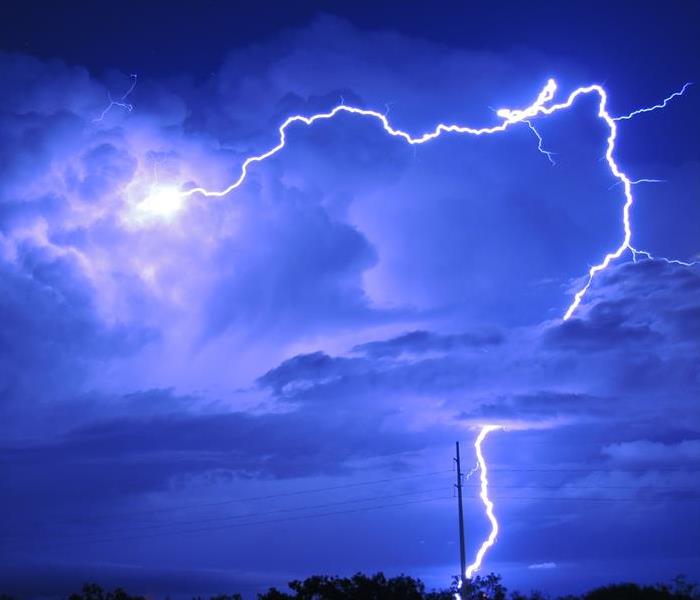 If you have damage from a severe weather event, SERVPRO of South Greenville County is here for all your restoration needs.
If you have damage from a severe weather event, SERVPRO of South Greenville County is here for all your restoration needs.
Do You Have A Safety Plan For Severe Weather?
If you live in the Greenville County area, you will eventually experience some form of severe weather. Severe weather is a terrifying thing to face. Not only can it cause significant damage to your home, but storms are unpredictable, and conditions can turn hazardous in the blink of an eye. The most important thing you can do before any severe weather event or storm is to make preparations so that you and your family will be safe. Have a safety plan in place in case intense weather moves swiftly into your area. Being prepared will alleviate panic because you will know what to do, where to go, and how exactly to keep yourself and your family safe.
By knowing where to go, where your supplies are, and that you have made sure you and your family can shelter in your home, you can have much more peace of mind surrounding your family’s safety.
Elements to Consider for a Severe Weather Preparedness Plan
Where Will You Seek Shelter?
You should always have a designated shelter spot in your home where everyone can head if the weather turns severe in an instant. Ideally, this would be a basement, but you can shelter in an area that does not have windows and does not have exterior walls if a basement is not available. An interior closet or a bathroom with no windows will be a great place to shelter until the storm subsides.
Do We Have Food and Water?
Once you seek shelter, it is wise you do not have to leave until the weather event has passed. It is a good idea to keep nonperishable foods and plenty of water in your shelter spot so you can stay put for the duration of the storm. You should store your food and water in a waterproof and tightly sealed container.
What Will Your Light and Power Source Be?
Power outages are common during severe weather, so it is a good idea to keep flashlights, l-e-d candles, and lanterns in your shelter area in case your home’s electricity goes out. Be sure to pack extra batteries, too, as they can lose their power with time. If possible, invest in a generator as well. Your area may be without power for several days, or you may not be able to safely leave your home for a few days after a storm. A generator can prevent food spoilage and allow you to carry on after the storm, should you not be able to leave your house for several days. A 5,000 to 7,500 watts generator gives enough power to run most household appliances.
If you have damage from a severe weather event, SERVPRO of South Greenville County is here for all your restoration needs. You can contact us as soon as you discover the damage for the quickest response possible, and with our 24/7 emergency line, you will never have to wait to get in touch. Call (864) 292-3137. For more information on SERVPRO of South Greenville County, please click here.
Before The Floodwaters Rise, Use These 11 Tips To Prepare The Outside Of Your Home.
7/14/2021 (Permalink)
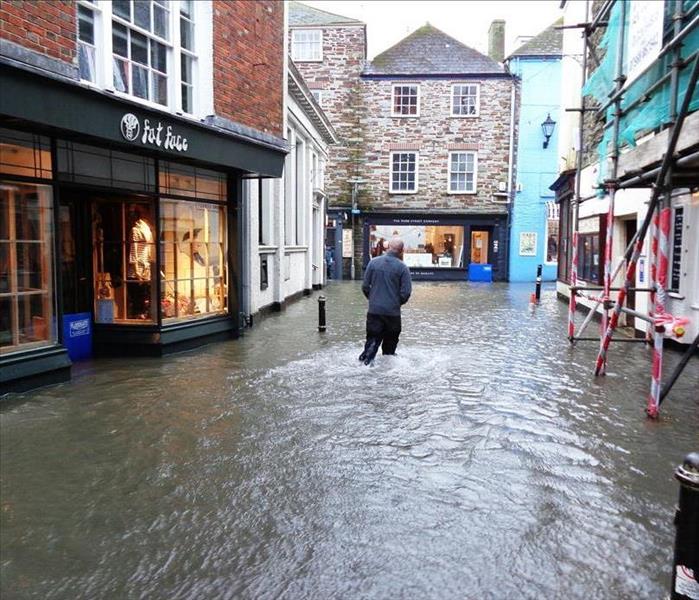 While you can't prevent flooding, there are several things you can do to prepare the outside of your home in advance to minimize the damage.
While you can't prevent flooding, there are several things you can do to prepare the outside of your home in advance to minimize the damage.
Before The Floodwaters Rise, Use These 11 Tips To Prepare The Outside Of Your Home.
So you bought a house in Greenville. Congratulations! You worked hard to move in and make your home your sanctuary. Owning a home is one of the most significant investments you will make in your lifetime. Why risk damaging or losing your home when bad weather strikes?
Flooding is the most common and expensive natural disaster in the United States and can happen anywhere at any time. One inch of water can cause significant damage to your home, which will rack up costly repairs. While you can't prevent flooding, there are several things you can do to prepare the outside of your home in advance to minimize the damage. Below are a few tips you can use to prepare your home for bad weather.
First, you need to determine the Base Flood Elevation (BFE) for your home. The BFE is the computed elevation to which the floodwaters are anticipated to rise. You need to know your home's BFE because it is used for flood plan management regulations in your community. Contact your local flood plan manager to you find your BFE.
- Water needs to drain away from your home. If you notice water pooling around your foundation or basement walls, consider improving the grading of your yard.
- Adding water-resistant exterior sheathing on walls and sealing them will prevent shallow flooding from damaging your home.
- If you see water pooling on damaged sidewalks, patios decks, or driveways, make repairs to prevent water from pooling too close to your home.
- Pick plants and vegetation that will minimize soil erosion when you are landscaping your yard and gardens.
- Secure your yard items before a flood or storm. Unsecure yard items can become hazardous during a flood or storm. They can be swept away or damaged by floodwaters, or they can also be swept into your home and cause more damage. Secure your yard items by anchoring them, attaching them to sturdier structures, or storing them indoors until the bad weather has subsided.
- If you have window wells, consider investing in window well covers so that water and does not accumulate in your window wells.
- Your downspouts need to extend three to six feet and drain away from your home.
- Use a rain barrel to catch rain runoff.
- Regularly clean and maintain your gutters and eavestroughs. Remove any leaves, twigs, and other blockages in your gutters or eavestroughs, so rainwater does not pool in your gutters or overflow onto your roof.
- Keep storm drains near your home clear of leaves, twigs, and other debris.
- If your roof is missing shingles or shingles are deteriorating, repair or replace your roof.
Remember, some of these tips may work better together than others. Not all of these options will work together; you should always consult with a professional such as your insurance agent, an architect, an engineer, a contractor, or other experts in construction before making any modifications to your home.
If your home floods-don't panic! Call SERVPRO Of South Greenville County. Our highly trained crews and state-of-the-art technology will make it "Like it never even happened." We will restore your home to preloss condition in no time. Give us a call at (864) 292 - 3137. We are available 24/7, 365 days a year.
Summer Safety Tips: Lightning Safety.
6/28/2021 (Permalink)
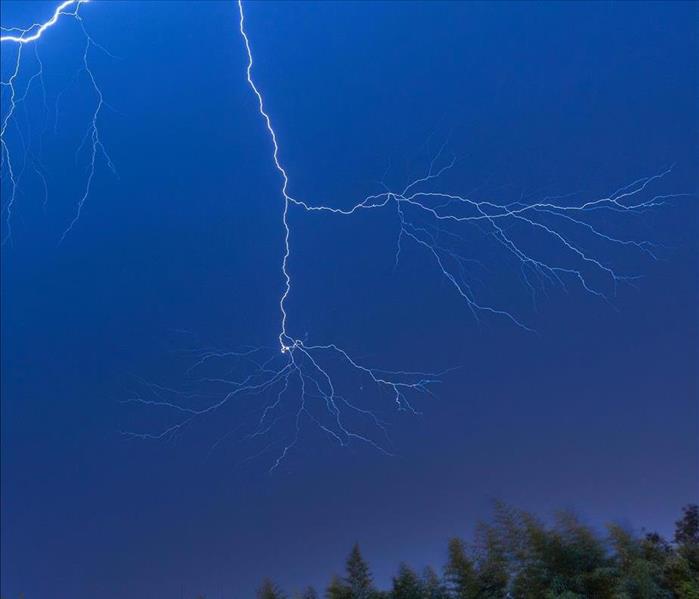 High-risk areas for attracting a return current or lightning strike are tall mountain peaks, ridges, and above treeline terrain.
High-risk areas for attracting a return current or lightning strike are tall mountain peaks, ridges, and above treeline terrain.
Summer Safety Tips: Lightning Safety.
It's officially summertime in Upstate South Carolina, which means more time outdoors! Unfortunately, warmer weather means pop-up thunderstorms. Whether you are hiking, camping, boating, fishing, or swimming, the potential for a bolt of lightning to strike you is something that you should always take seriously.
You should avoid being outside during a lightning storm. Check the weather first and decide if you need to change your plans for the day. Head back inside early if you see dark clouds forming and hear thunder in the distance. Reducing and managing the risk of getting struck by lightning is possible through a few safety procedures. Below are a couple of tips you can use if you find yourself suddenly caught in a lightning storm.
Mountains
High-risk areas for attracting a return current or lightning strike are tall mountain peaks, ridges, and above treeline terrain. In Upstate South Carolina, quick pop-up afternoon storms create the perfect conditions for lightning to strike. These pop-up storms typically arrive in the afternoon, but it is not uncommon for them to begin earlier in the day. If you're out hiking and you hear thunder above the treeline, turn around immediately and get back to the shelter of the treeline. Never hide in the entrance of a cave.
If you see sparks on metal objects or your hair begins to stand up, this is called a corona- which means that your body is signaling towards an imminent strike. If this happens, drop everything metal and crouch down in a ball-like position with your head tucked and hands over your ears; so that you are down low with minimal contact with the ground. This position is called the lightning safety position.
If you are camping, remember you should never pitch tents above the treeline. If you cannot avoid an exposed campsite, then you must get out of the tent and move at least 50 meters away in the event of a storm. Wait in the lightning position until the storm has passed.
Rolling Hills and Gentle Terrian
It is rare that lightning strikes in this type of terrain. Run for shelter if you hear thunder, but if you see lightning striking nearby, get in the lightning position.
Fields
If you are out in an open field during a lightning storm, move more than 50 meters away from conductors such as fences and irrigation pipes, these attract lightning. Do not seek shelter under trees or by telephone poles if they are too close to a fence or irrigation pipes.
Forests
Do not take shelter under a lone tall tree during a lightning storm. However, uniform canopy forests are much less at risk of attracting lightning. Avoid trunks of large trees, but it is better to be under that type of shelter instead of out in the open.
Water
Swimming in a pool or boating on flat water such as lakes, wide rivers, or the ocean leaves you exposed to lightning strikes. Plan aquatic activities around the weather, and if you hear thunder in the distance or you see dark clouds forming, get to shore as quickly as possible.
Tornado Safety Tips
2/23/2021 (Permalink)
Tornado Safety Tips
Last April, a tornado tore through Upstate South Carolina, leaving behind severe damage in Oconee County. Many residents sought safe shelter and remained physically unharmed. As we approach the first anniversary, we wanted to remind everyone of a few tips to keep you safe, should this happen again.
- Pick an interior room in your home to take cover. A cellar, bathroom, or closet are ideal places to wait out a tornado. Avoid rooms with windows. If you can't decide where to go, choose your bathroom. The tub is the safest place to be during a tornado.
- If you get stuck outdoors, find a ditch and lay down as flat as you can. Stay far away from items that can fly through the air.
- Do not stay in a car or try to drive away from a tornado. Cars can be lifted by high winds or crushed by debris.
- If you evacuate your home, do not return until local officials have said it is safe to do so.
Be Prepared For Winter Weather.
12/15/2020 (Permalink)
Upstate South Carolina doesn't often experience frigid temperatures, but icy winter storms can cause property damage, create safety risks, close roads, and major highways, and cause area-wide power outages. Before severe weather, you should do your best to prepare. Below are a few things you can do to make sure you are ready for whatever winter weather comes our way.
- Add rock salt to melt ice and shovels to your disaster supply kit.
- Make sure you have sufficient heating fuel, in case you become stuck in your home.
- Know where your shut-off valves are located and how to shut off water valves in case a pipe bursts.
- Have your vehicle serviced to ensure it is prepared for colder weather.
- Create a winter emergency kit that includes a shovel, windshield scraper, small broom, flashlight, battery-powered radio, extra batteries, water, snack food, extra warm clothes, first aid kit, pocket knife, extra medication, blankets, rope, and tow chain, road salt, booster cables, emergency flares, and a fluorescent distress rag.
Hurricane Season Is Here Are You Ready?
9/18/2020 (Permalink)
Hurricane Season Is Here Are You Ready?
We have reached the peak of hurricane season. Although the Coast and Midlands will face more destruction than the Upstate, we in the Upstate need to be prepared for flooding, power outages, and whatever else a hurricane decides to throw our way. You should have the following items packed and ready to go in case any emergencies arise.
- A three day supply of water. One gallon of water per person per day.
- A three day supply of easy to prepare non-perishable food for each person in your household.
- At least a seven day supply of medication and extra medical items. Don't forget extra batteries, hearing aids, glasses, contact lenses, syringes, and canes if needed.
- Include extra laminated copies of personal documents such as medication lists, pertinent medical information, deed/lease to home, birth certificates, and insurance policies. You need to include a laminated copy of family information and emergency contact information.
- If you have an infant or toddler, add extra bottles, formula, baby food, and diapers.
- A fully stocked first aid kit needs to be included.
- If you have pets, include extra leashes, collars, food, water, carriers, and bowls for each pet.
- A few extra things you need to include are a flashlight, extra batteries, emergency blankets, extra clothes, maps of the area, cash, cellphones with extra chargers, a multipurpose tool, a camera to take photos of the damage.
If you have damage from a recent storm, call SERVPRO of South Greenville County (864) 292-3137.
3 Reasons To Stay Off The Road During A Storm
9/4/2020 (Permalink)
3 Reasons To Stay Off The Road During A Storm
We all hate being stuck indoors, especially when it's raining. However, as bad as you want to get out during a storm, you must avoid driving when roads begin to flood. A flooded street may seem easy to navigate, but it's a risk to your safety. The following are just a few reasons why it is best to stay off the roads during severe weather.
1. It can damage your vehicle
Your car is not made to drive through large amounts of water. It is not equipped with the necessary equipment to protect it from water damage. Your engine could easily become flooded, causing your car to malfunction. Electric components can short out, and areas of your car can rust, leaving you with a massive repair bill.
2. There may be hidden road damage
A flooded road may appear safe, but you never know what could be lurking beneath the water's surface. Potholes, tree branches, and other debris from the storm, could be hidden under the water. These can further damage your car and make it more difficult for you to drive safely.
3. You could lose control of your car
Whether you've been driving for a few years or a few decades, you can't be prepared for everything. Just six inches of water can sweep you and your car away. One of the best travel tips for driving during a flood is to simply not to do it. Stay put if possible, and once the water has receded, you can find a more comfortable place to stay. If you come across a large area of water, follow the turn around don't drown method.
Is Your Home Ready For A Storm?
8/7/2020 (Permalink)
Is Your Home Ready For A Storm?
You cant control the weather or what storms will damage. You can, however, protect your home by preparing for oncoming inclement weather.
- Repair Loose Siding: It's important to ensure your siding isn't damaged. If a piece of siding is loose, it's more likely it will break free. If a piece is missing, then there is a gap for the wind to get under and do more damage.
- Ensure Water Can Flow Away From Your Home: The group of your lot should keep water flowing away from your home and into a ditch or a drain.
- Walk Around Your Property: Identify the items around your property that could become projectiles. Things like lawn furniture, tools, flower pots, and other yard debris should be moved to the garage, shed, or indoors.
- Ensure All Doors and Windows Are Sealed Properly: Wind only needs a small opening to get underneath something and cause damage. If windows and doors aren't sealed properly, then that small opening could enlarge and compromise the inside of your home or roof.
Tornado Hits Local Church SERVPRO of South Greenville County Here To Help
6/12/2020 (Permalink)
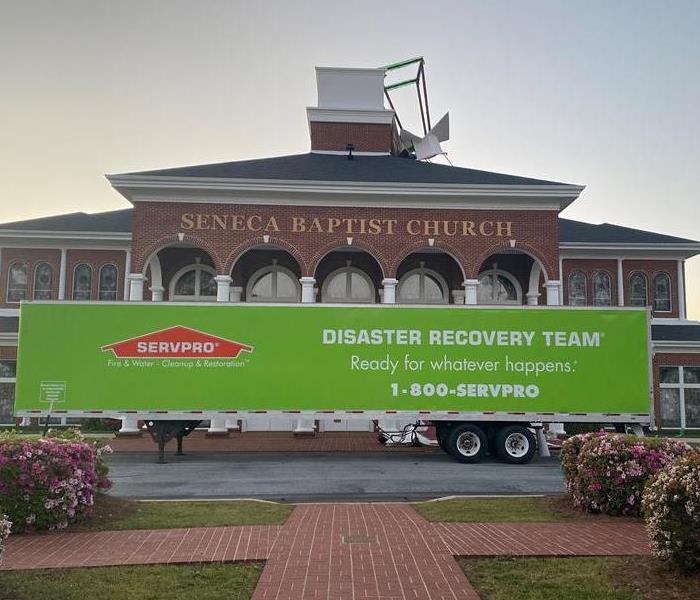 Tornado Hits Local Church SERVPRO of Greenville County Here To Help
Tornado Hits Local Church SERVPRO of Greenville County Here To Help
Around three am, on the Monday after Easter Sunday, an EF 3 tornado touched down in Oconee County. Many families took precautions and ran to shelter before the tornado touched down. Unfortunately, due to the strength of the tornado, all of Oconee County experienced some form of damage.
Seneca Baptist Church withstood the tornado but, a portion of the roof peeled back, leaving the pews and carpet in the sanctuary exposed to rainwater and debris. The church had no power or water, leaving them with a hurdle to overcome on the road to recovery. Thankfully they made a call to SERVPRO of South Greenville County.
Our team arrived and began working. Several generators were set, and power distribution boxes were installed to help run our specialty drying equipment. Crew members quickly realized we needed to call in our Storm Team to help with the drying process. They brought a trailer load full of dehumidifiers and other drying equipment. Together, we were able to dry the church and make it "Like it never even happened."
A Flood Is Coming, Are You Prepared?
2/13/2020 (Permalink)
Flooding can result from rain, snow, coastal storms, storm surges, or water systems overflowing. Although flooding can develop slowly or quickly and is temporary, knowing what to do before a flood hits, can keep you safe.
What Can You Do Beforehand?
- Know the type of flood risk in your area.
- Make sure you have signed up for your community's warning system.
- If flash floods are a risk in your location, monitor potential signs.
- Learn evacuation routes, shelter plans, and practice your flash flood response.
- Make an emergency kit and keep it a safe place. Include items for your pets and extra medication.
- Purchase or renew a flood insurance policy. Remember, it takes 30 days for a new policy to go in to affect.
- Keep important documents in a waterproof container. Create and save password-protected digital copies.
- Before rain or snow, clean out your gutters. Move your valuables to higher locations.
What To Do During an Earthquake
2/6/2020 (Permalink)
What To Do During An Earthquake
Imagine you're at home or work, or maybe you're outside when suddenly the ground begins to shake violently. After a few seconds, you realize what's happening, its and earthquake. Would you know what to do in this situation? If not, we have compiled a list of what you need to do during an earthquake.
- Remain calm. If you are indoors, remain indoors. If you are outside, stay outside.
- If you're indoors, stand against a wall, stand in a doorway, or crawl under heavy furniture. Stay away from windows and outside doors.
- If you're outdoors, stay in the open away from power lines or anything that might fall. Stay away from buildings.
- Don't use matches, candles, or any flame. Broken gas lines and fire don't mix.
- If you're in a car, stop and stay inside the car until the earthquake stops.
- Don't use elevators.
What To Do Before An Earthquake
2/5/2020 (Permalink)
An earthquake is the shaking of the surface of the Earth, resulting from a sudden release of energy in the Earth's lithosphere. Earthquakes can range in size from weak, where they can't be felt, to violent, where destruction can wreak across entire cities. However, before an earthquake hits, there are a few things you can do to minimize damage to your home and ensure you stay safe.
What To Do Before an Earthquake:
- Anchor heavy furniture, cupboards, and appliances to the walls or floor.
- Don't leave heavy objects on shelves.
- Make a plan of where to meet your family after an earthquake.
- Make sure you have a fire extinguisher, first aid kit, a battery-powered radio, a flashlight, and extra batteries at home.
- Learn how to turn off the gas, water, and electricity. Turn the utilities off before the earthquake hits.
- Learn the earthquake plan at your school or workplace. know
Before the shaking begins, know how to protect yourself!
Frozen Pipes? No Problem! Thaw Them With These Steps!
12/9/2019 (Permalink)
How To Thaw Frozen Pipes!
The winter freeze is quickly approaching. Which means your pipes may freeze. If you try to turn on your facet on an icy day and only a trickle comes out, you may have a frozen pipe. Don't worry! We have accumulated a few tips to help you thaw out frozen pipes and keep your home from flooding this winter.
- Turn on your faucet. As the frozen pipe heats up, the ice plug will begin to melt. Running water through the pipe will help melt ice in the pipe.
- Apply heat to a section of pipe. Do not use any device with an open flame to heat the frozen pipe. The high heat can start a fire or damage the pipe. Instead, use an electric heating pad or hairdryer.
- Apply heat until the water pressure is restored. Check all the faucets in your home and see if water pressure is restored. If it's not, you may have another frozen pipe.
- Call a licensed plumber If you are unable to locate the frozen pipe, if the area is not accessible, or if you cannot thaw the pipe yourself.
If a pipe bursts in your home, don't stress! Call SERVPRO of South Greenville County 864-292-3137!
How to Prepare For A Hurricane Before Its Too Late
9/4/2019 (Permalink)
How to Prepare For A Hurricane Before It's Too Late
Hurricanes are massive storms that form over the ocean and move towards land. A hurricane can cause massive amounts of destruction, devastation, and unsafe conditions. Taking the time to prepare now can make a big difference in your safety. Follow these tips below to help you prepare before its too late.
- Sign up for local alerts and warnings.
- Learn your emergency evacuation route for your city or town.
- Protect your property by removing any dead limbs and outdoor furniture, and securing anything that could become airborne or hazardous during the hurricane.
- Make an emergency preparedness kit.
- Collect any financial, medical, educational, and legal documents and put them in your emergency kit. Bring them with you if you evacuate.
- Stock up on emergency supplies. You should have at least a three day supply of water and non-perishable food in your emergency kit, as well as extra medication, a first aid kit, hygiene items, and spare clothes.
When A Storm Rolls In Call SERVPRO of South Greenville County.
8/8/2019 (Permalink)
This homeowner was relaxing and listening to the rain pour outside. Suddenly he noticed the carpet in his finished basement was getting wet. Rather than panicking, he gave SERVPRO of South Greenville County a call.
Once our crew arrived at the loss, they began assessing the damage. Our technicians discovered the water came from outside the home. They devised a drying plan perfectly tailored for this home. This plan allowed for successful mitigation while maintaining most of the structure. Our team began extracting the standing water from the carpet. Next, the carpet padding and portions of the baseboards were removed. Then, drying equipment was set up to dry out the wet areas and subfloor. When everything was dry, the carpet was treated and cleaned. The customer was blown away with the end result.
When you have storm damage - don't hesitate to call SERVPRO of South Greenville County 864 - 292 - 3137!
When Storms or Floods hit South Greenville County, SERVPRO is ready!
11/19/2018 (Permalink)
When Storms or Floods hit South Greenville County, SERVPRO is ready!
SERVPRO of South Greenville County specializes in storm and flood damage restoration. Our crews are highly trained and we use specialized equipment to restore your property to its pre-storm condition.
Faster Response
Since we are locally owned and operated, we are able to respond quicker with the right resources, which is extremely important. A fast response lessens the damage, limits further damage, and reduces the restoration cost.
Resources to Handle Floods and Storms
When storms hit South Greenville County, we can scale our resources to handle a large storm or flooding disaster. We can access equipment and personnel from a network of 1,650 Franchises across the country and elite Disaster Recovery Teams that are strategically located throughout the United States.
Have Storm or Flood Damage? Call Us Today 864-292-3137
What To Do After a Thunderstorm
10/18/2018 (Permalink)
What To Do After a Thunderstorm
Take the Appropriate Steps to Stay Safe:
- Never drive through a flooded roadway. You cannot predict how deep the water may be. It only takes 12 inches of water to move a small vehicle and 18 inches to move a large vehicle.
- Stay away from storm-damaged areas to keep from putting yourself at risk from the effects of severe thunderstorms.
- Continue to listen to a NOAA Weather Radio or to your local radio and television for updated information or instructions, as access to roads or some parts of the community may be blocked.
- Help people who may need special assistance, such as infants, children, the elderly or the disabled.
- Stay away from downed power lines and report them immediately.
- Watch your animals closely. Keep them under your direct control.
If Lightning Strikes
Follow these steps if someone has been struck by lightning:
- Call for help. Call 9-1-1 or the local emergency number. Anyone who has been struck by lightning requires medical care.
- Check the person for burns and other injuries. If the person is not breathing, call 9-1-1 and begin CPR. People who have been hit by lightning do no retain an electrical charge and can be handled safely.
Recovering After a Thunderstorm
Flood Warning versus Flood Watch
10/18/2018 (Permalink)
Flood Warning versus Flood Watch
Flash Flood Warning: Take Action! A Flash Flood Warning is issued when a flash flood is imminent or is already occurring. If you are in a flood-prone area, you should move to higher ground. A flash flood is a sudden violent flood that can take from minutes to hours to form. It is possible to experience a flash flood in areas that are not immediately receiving rain.
Flood Warning: Take Action! A Flood Warning is issued when the hazardous weather event is imminent or already happening. A Flood Warning is issued when flooding is imminent or already occurring.
Flood Watch: Be Prepared: A Flood Watch is issued when conditions are favorable for a specific hazardous weather event to occur. A Flood Watch is issued when conditions are favorable for flooding. It does not mean flooding will occur, but it is possible.
Flood Advisory: Be Aware: A Flood Advisory is issued when a specific weather event that is forecast to occur may become a nuisance. A Flood Advisory is issued when flooding is not expected to be bad enough to issue a warning. However, it may cause significant inconvenience, and if caution is not exercised, it could lead to situations that may threaten your life or your property.
Flood Warning vs. Watch
Severe Thunderstorm Watch versus Severe Thunderstorm Warning
10/16/2018 (Permalink)
Severe Thunderstorm Watch versus Severe Thunderstorm Warning
According to the Redcross, a thunderstorm that produces hail at least 1 inch in diameter or produces wind gusts of at least 58 mph, is considered severe. Thunderstorms produce lightning. Lightning kills more people each year than tornadoes and hurricanes. Thunderstorms can produce heavy rain, flash floods, and high winds. These effects can cause damage to homes and power outages.
Know The Difference
Severe Thunderstorm Watch - this means severe thunderstorms are possible in and near the designated watch area. You should stay informed and be ready to act if and when a severe thunderstorm warning is issued.
Severe Thunderstorm Warning - Severe weather has been reported by spotters or indicated by weather radar. The warning indicates there is an imminent danger to your life and your property.
About Thunderstorms
What To Do During a Thunderstorm
10/16/2018 (Permalink)
What To Do During a Thunderstorm
- Stay updated by listening to your local news or NOAA Weather Radio. Watch for the signs of a storm, like flashes of lightning, high winds, and dark skies.
- If thunderstorms are likely, stay indoors. Often, people who were struck by lightning were not in the area where rain occurred.
- When a severe thunderstorm warning is issued, you should take shelter in a sturdy building or in a vehicle with the windows closed. Do not take shelter in a mobile home, as they can blow over in high winds.
- If you can hear thunder then you are close enough to be in danger of getting struck by lightning. The National Weather Service recommends staying inside for at least 30 minutes after the last thunderclap.
- Avoid using electrical equipment, appliances, and telephones. Use battery-powered TVs and radios instead.
- Shutter windows and close and secure outside doors. Keep away from windows.
- Do not use plumbing, bathe or shower during a thunderstorm.
- If you are driving, safely exit the roadway and park. Stay in your vehicle and turn on your emergency flashers until the rain ends. Avoid touching metal or anything that can conduct electricity in or outside the vehicle.
- If you are trapped outside and cannot make it indoors, avoid high ground; water, tall isolated trees; and any metal objects. It is not safe to stay in picnic shelters, dugouts or sheds.
Responding Appropriately During a Thunderstorm
 Storm damage can leave your home in ruins, but SERVPRO® is here to help with expert storm cleanup and restoration services.
Storm damage can leave your home in ruins, but SERVPRO® is here to help with expert storm cleanup and restoration services.



 24/7 Emergency Service
24/7 Emergency Service
